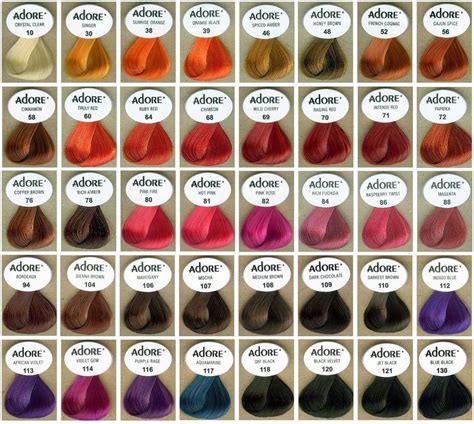Adore Color Chart: A Guide to Understanding, Selecting, and Using Colors

Color is an essential element in design, art, and everyday life. It can evoke emotions, convey messages, and create a desired atmosphere. Understanding color theory is key to effectively using colors to achieve your desired outcomes. This article provides a comprehensive guide to the adore color chart, helping you grasp the nuances of color theory and make informed color choices.
The adore color chart is a visual representation of the most common colors used in design and printing. It consists of 216 colors arranged in a grid pattern, with each row representing a different hue or shade. The chart is organized into four quadrants based on the primary colors: red, green, blue, and yellow.
When selecting colors from the adore color chart, consider the following factors:
1. Color Harmony: Choose colors that complement each other to create a harmonious and visually appealing design.
2. Color Contrast: Use contrasting colors to create emphasis and draw attention to certain elements.
3. Color Meaning: Different colors have different associations and meanings. Choose colors that align with the message you want to convey.
4. Color Accessibility: Ensure that your color choices are accessible to people with color blindness or low vision.
The adore color chart has numerous applications in various fields, including:
1. Design: Architects, designers, and graphic artists use the chart to select colors for logos, websites, interiors, and other design projects.
2. Printing: Printers use the chart to calibrate their equipment and ensure accurate color reproduction.
3. Art: Artists use the chart to create color palettes and experiment with different color combinations.
4. Education: Educators use the chart to teach students about color theory and its practical applications.
1. Use Color Samples: Request physical samples or use digital color simulations to see how colors will appear in real-life applications.
2. Consider Tone and Shade: When selecting colors, pay attention to the tone and shade to create a desired mood or effect.
3. Experiment with Different Combinations: Don’t be afraid to mix and match colors to find unique and eye-catching combinations.
4. Seek Professional Advice: If you need help selecting colors, consult with a professional designer or color consultant.
1. Consistency: The adore color chart provides a standardized reference point for color selection, ensuring consistency across different applications.
2. Accuracy: The chart ensures accurate color reproduction, reducing errors and inconsistencies in printing and design.
3. Inspiration: The chart offers a wide range of color options, providing inspiration and expanding creative possibilities.
4. Accessibility: The adore color chart is accessible to anyone, making it easy to share and discuss color choices.
| Feature | Adore Color Chart | Other Color Charts |
|---|---|---|
| Number of Colors | 216 | Varies |
| Color Model | CMYK | RGB, HSB, Pantone |
| Applications | Design, Printing, Art | Most Common |
| Accessibility | Standardized | May vary |
| Price | Paid | Free or Paid |
The adore color chart is an indispensable tool for anyone working with colors. Its comprehensive range of colors, standardized reference point, and practical applications make it a go-to resource for designers, artists, printers, and educators. By understanding the principles of color theory and utilizing the adore color chart effectively, you can make informed color choices that create desired outcomes and enhance your creativity.
